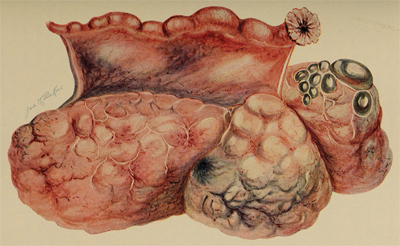MCP: Ovarian cancer’s dark signaling pathways
Ovarian cancer is considerably rarer than lung and breast cancer, but it is the seventh-most common cancer in women, and in 2012, 239,000 new cases were diagnosed worldwide. The most common subtype of ovarian cancer, high-grade serous ovarian adenocarcinoma, or HGSOC, is also the most lethal, with a five-year survival rate of less than 40 percent despite high vulnerability to early treatment with chemotherapy.
 This image from the 1905 text, “The diagnosis of diseases in women” by Findley Palmer, shows an adenocarcinoma of the ovary in which, according to the caption, “(t)he ovary is enlarged to the size of a child’s head.”
This image from the 1905 text, “The diagnosis of diseases in women” by Findley Palmer, shows an adenocarcinoma of the ovary in which, according to the caption, “(t)he ovary is enlarged to the size of a child’s head.” WIKIMEDIA COMMONS/THE LIBRARY OF CONGRESS
The mortality rate is high largely because HGSOC tumors tend to shed small spheroids early and prolifically, spreading through the peritoneal fluid in the abdominal cavity to the pelvis and nearby organs. The spheroids, together with tumor-associated T cells and macrophages derived from nearby tissues and the circulation, then manufacture a microenvironment of signaling factors that promote cancer progression, immunosuppression and resistance to chemotherapies. This hostile bubble is maintained by obscure signaling mechanisms between the different cell types, and disrupting them with existing drugs may be a way to fight this notably aggressive form of cancer.
In a paper published in the journal Molecular & Cellular Proteomics, researchers at Philipps University in Marburg, Germany, have analyzed the proteome and transcriptome of the microenvironment of tumors in the abdominal fluid taken from women with HGSOC. Using state-of-the-art proteotranscriptomic techniques, the researchers have thrown light on the signaling networks and uncovered associations between factors expressed by the tumors and the likelihood of patient survival.
“We came up with a signaling map between tumor cells, macrophages and T cells,” said Rolf Müller, senior author on the paper, “and could now analyze and determine which cells secrete which mediators and on which cells these mediators act.”
Müller and colleagues previously had developed a signaling map based on the RNA, or transcriptome, expressed in tumor cells and related macrophages, but they wanted to expand their analyses to encompass the proteome and the aggregate of secreted molecules known as the secretome. Analyses of the transcriptome, proteome and secretome, Müller said, “all have their limitations on their own, (but) you can combine them to obtain something really meaningful.”
With a signaling map, Müller and colleagues were able to confirm several known signaling pathways and identify two new subgroups of macrophages, which they named B and G for their respective presence in patients with bad or good prognoses.
Müller and colleagues found that tumor spheroids and macrophages taken from patients with an estimated short survival time, based on the presence of additional factors, produced proteins that support remodeling of extracellular matrices and immunosuppression, which are both key for further cell proliferation. In contrast, macrophages taken from patients with an estimated longer survival time expressed cytokines linked to the activation and attraction of tumor-fighting effector T cells.
While clinical trials are still beyond the horizon, Müller and first author Thomas Worzfeld said they and their colleagues are interested in exploring the gamut of available pharmaceuticals that can interrupt the signaling within tumors as an alternative to disrupting extracellular communication pathways.
“There’s a drug to block almost any important intracellular signaling pathways nowadays,” Müller said, “and it would be interesting to see what the important signals are and on what intracellular signaling pathways the signals converge so that we can also block these interactions. That is something we really would like to work on in the future.”
Enjoy reading ASBMB Today?
Become a member to receive the print edition monthly and the digital edition weekly.
Learn moreGet the latest from ASBMB Today
Enter your email address, and we’ll send you a weekly email with recent articles, interviews and more.
Latest in Science
Science highlights or most popular articles

What is metabolism
A biochemist explains how different people convert energy differently – and why that matters for your health.

What’s next in the Ozempic era
Diabetes, weight loss and now heart health: A new family of drugs is changing the way scientists are thinking about obesity — and more uses are on the horizon.

How a gene spurs tooth development
University of Iowa researchers find a clue in a rare genetic disorder’s missing chromosome.

New class of antimicrobials discovered in soil bacteria
Scientists have mined Streptomyces for antibiotics for nearly a century, but the newly identified umbrella toxin escaped notice.

New study finds potential targets at chromosome ends for degenerative disease prevention
UC Santa Cruz inventors of nanopore sequencing hail innovative use of their revolutionary genetic-reading technique.

From the journals: JLR
How lipogenesis works in liver steatosis. Removing protein aggregates from stressed cells. Linking plasma lipid profiles to cardiovascular health. Read about recent papers on these topics.

